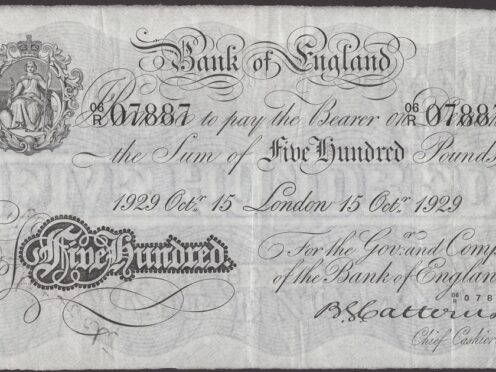
A rare £500 note is expected to fetch up to £24,000 when it goes under the hammer at auction.
The note dates from October 1929 and is the only known surviving £500 note signed by Basil G Catterns, who was chief cashier of the Bank of England between 1929 to 1934.
It is being sold at Noonans Mayfair on March 14 by a long-time collector of British notes, who has owned it for almost 15 years.

Andrew Pattison, from Noonans, said: “This is a staggeringly rare and important note, and it is in wonderful clean condition, especially considering it is now almost 100 years old.
“For anyone who collects Catterns notes or indeed any Bank of England notes, this would be likely the pinnacle of their collection.”
The £500 note is one of several Bank of England notes in the sale – all of which have rarely been seen at auction for several decades.
An exceptionally early £50 note dating from April 1780 is estimated to fetch between £26,000 and £32,000.
It is signed by Abraham Newland, who was chief cashier between 1782 and 1807, and is being sold by another long-term collector of Bank of England notes.
“Abraham Newland was quite a character, who apparently slept in the bank for 25 years,” Mr Pattison said.
“This is one of only two notes of this denomination to be recorded – so it is truly remarkable.”
An 1894 £100 note from the Birmingham branch of the Bank of England and signed by Horace G Bowen, who was chief cashier between 1893 and 1902, is estimated to sell for between £24,000 and £30,000.

“This is one of only two surviving Bowen notes above £5 issued anywhere other than London, and its condition is spectacular,” Mr Pattison said.
“It would be a jewel in the crown of almost any 19th century banknote collection.”
A very rare £5 note from the Bank of England branch in Bristol dating from June 1850 and signed by Matthew Marshall, who was chief cashier between 1835 to 1864, is estimated to fetch between £15,000 and £20,000.
It is stamped issued by Tugwell, Clutterbuck and Ricardo, who were a local bank in Bath.
The sale will also include a large variety of banknotes from English Provincial banks as well as banks in Ireland, Scotland, Isle of Man, Jersey, and Guernsey.
The very first Manx Bank note ever issued will be included in the sale.
The £1 note, with serial number one, dates from November 1882, is decorated with an image of the Tower of Refuge in Douglas harbour and is expected to fetch between £10,000 and £15,000.
Mr Pattison added: “This is an absolutely astonishing note and, in my opinion, the finest Isle of Man note in existence.
“The imagery on it is iconic, showing locations everyone on the island knows and loves, and the fact that it is serial number one of the issue is a remarkable bonus.”

Enjoy the convenience of having The Sunday Post delivered as a digital ePaper straight to your smartphone, tablet or computer.
Subscribe for only £5.49 a month and enjoy all the benefits of the printed paper as a digital replica.
Subscribe